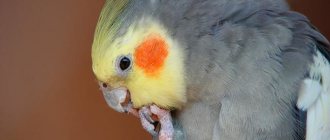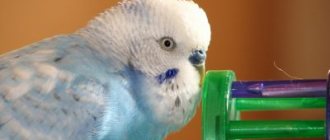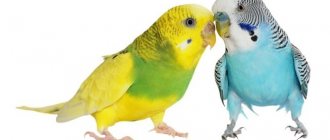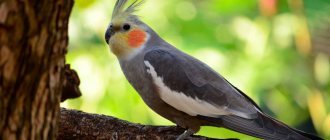A pet always brings a lot of positive emotions, joy and fun. Especially if your feathered companion is a parrot. This is an affectionate, active, sociable bird that takes root well in captivity and becomes very attached to humans. In addition, parrots have another ability that distinguishes their species from all other birds - they can be taught to talk.
Many people, when they decide to have a parrot in their home, count on being able to teach the bird to speak. However, many of them have a very vague idea of not only how to do it correctly, but also do not know which parrots can be taught to speak and which ones - even if you don’t try so hard, the bird will still not be able to greet its owner when he returns home. We decided to fill this information gap and help not only choose the parrot that can be taught to speak, but also tell you how this can be done. However, be prepared for the fact that such training will take hours, or even weeks, and the more systematic and competent your approach to training is, the faster your bird will speak.
What parrots can be taught to speak?
It is a well-known fact that parrots are capable of reproducing human speech. However, birds do not “talk” on their own. In order for your pet to say at least one word, training is necessary. This process is lengthy; it is not easy to teach a bird to pronounce words. Depending on the bird’s abilities and its species, training can take from 3 months to a year, subject to daily regular training. Note that there are birds that are not capable of reproducing words. Let's look at the most popular types of parrots for their learning ability:
- Wavy. Is it possible to teach a budgie to talk? This species is considered one of the most chatty. They begin to “speak” earlier than others, but it is still not possible to quickly teach them human words. The vocabulary of these birds can reach several hundred words, and their pronunciation can be called perfect. There are cases where budgies reproduced poetry. A trusting relationship with your pet will help speed up the learning process. However, for the bird to “speak” it will take not a single day or even a month.
- Corella. This type of parrot does not have special learning abilities. It is quite possible to teach a cockatiel to talk, but the process is more difficult and lengthy than in the case of budgies. In addition, the vocabulary of these birds is less rich and the pronunciation of words is not as clear. A cockatiel can learn no more than 10 words. Only young individuals can be trained. Adult birds are not capable of reproducing words.
If the pet is young, then training should begin with hand training. After the bird ceases to be afraid of people, they begin directly to speech exercises and activities. Corella is a smart pet and can become a “teacher” himself. A “talking” parrot of this species can teach speech to other birds and small children.
- Lovebird. These pets are among the most taciturn when it comes to human speech. At the same time, individual individuals can be trained. A lovebird can learn the pronunciation of 5 words. The learning process will be long; parrots of this species do not learn words quickly. In addition, only young individuals can learn to “speak.” If the lovebird “speaks,” then he will pronounce the words clearly.
- Rosella. This species, like the previous ones, does not differ in speech abilities. Rosella can learn a few words. The bird's vocabulary is limited to the name of the owner and some other word that is directly related to the bird itself. Learning to speak in rosellas is a long process and not always successful. If you expect that your pet will be able to learn a few phrases, then don’t get your hopes up.
- Cockatoo. This bright giant has not only an exotic appearance, but also high learning abilities. The cockatoo is capable of reproducing human speech - words and individual phrases. This feature of the bird allowed him to become one of the most popular participants in circus shows. However, it takes a lot of time to train a pet. It is not possible to quickly teach a cockatoo to speak.
- Jaco. The smartest parrots are grays. Their unprepossessing appearance is more than compensated by the bird's ability to imitate the human voice. According to breeders, the Gray Gray is the most chatty bird among parrots. His vocabulary contains at least a hundred words and short phrases. Thanks to its inquisitive mind, the Gray learns quickly, remembers words for a long time and is able to use them exactly in accordance with the situation.
The influence of parrot gender on predisposition to learning
Young males learn to talk best, so here we are writing more about how to teach a boy’s budgie to talk, because with females both the timing and the quality of the result can change. Of course, it happens that a female budgerigar can talk, but they are definitely more difficult to teach, and even with some progress, it is quite difficult for them to repeat words. But if you manage to teach a female to speak, she will pronounce words more clearly than most males, and this is a huge victory!
If you already have a talking wavy male, then when you add a young female, he can teach her some words, but this process is completely uncontrolled, and no one can guarantee you such a development of events.
At what age is the best time to adopt a budgie?
Young budgerigars leave the nest at the age of 30 days (deviations in either direction are about 5 days). At first, the chicks fly after their parents, begging them for food, but at the same time, almost from the first day after leaving the nest, most chicks already begin to eat on their own.
The sooner the bird gets to you, the better. The age of 35-40 days is the most promising, but parrots that were separated from their parents at the age of 50 days also began to speak.
You need to choose a strong bird that is already capable of flight. Beware of purchasing a parrot that sits ruffled, with its head hidden under its wing, and sits on the floor of the cage. This chick is either sick or too young and may die in a few days.
All parrots have a so-called cere at the base of the beak - a featherless area on which the nasal openings are located (except for parrots, only owls have a cere).
How to determine the sex of a parrot by wax
The age and sex of budgerigars are distinguished by their cere. In young males who have just left the nest, it is usually convex and pale pink in color. Then the color of the cere changes and at the age of the parrot about three months it becomes light blue, and later it darkens and by five to six months it already becomes bright blue, the same as in completely adult birds.
In young females, the cere is either completely white, or in some cases pale blue, only there are white areas near the nasal openings. It is sometimes difficult to distinguish such birds from young, three-month-old males. However, two to three weeks pass, and in females the blueness disappears completely, the wax becomes white. When the female begins to nest, her cere sometimes turns brown. Pay attention to the coloring of the selected birds. Green parrots quickly begin to imitate human speech. Under natural conditions in Australia, all wavy companions are green. Only through selection did man manage to change their color.
The influence of budgerigar gender on receptivity to learning
It is known that the sex of a parrot plays an important role in its ability to learn to speak.
Males are more susceptible to onomatopoeia than females, and if you absolutely want your parrot to talk quickly, choose a male.
This fact is confirmed by examples of a record vocabulary possessed by males. So the most sociable is the budgerigar Puck, who knew 1770 words. However, this does not mean that girls cannot “speak” at all. The exception is the female Australian parrot.
It is more difficult to teach females to speak, and it will take longer to work with the bird, but females pronounce words clearly, cleanly and loudly. There are also cases when a talking male was placed next to a female, and after a while she also began to repeat some words.
Rules for teaching parrots to talk
The process of teaching a parrot to speak is long and laborious. It requires patience from the person who has taken on the role of teacher. According to ornithologists, parrots perceive the speech of women and children better, so the owner of the pet is preferable as a teacher. One person should handle the bird. In addition, the following rules should be taken into account:
- Classes are conducted in complete silence, as parrots are naturally terribly curious. If the silence regime is not observed, the “student” will become distracted and will not remember the required combination of sounds. Particular attention should be paid to the TV. The sounds coming from it will not allow the bird to concentrate.
- Teaching words should be accompanied by corresponding action. When learning the word “hello”, you should enter the room, and “bye” is said if you leave the room.
- Classes should be scheduled at the same time. The duration of the lesson should be 15-20 minutes. In addition, once a week it is recommended to conduct a long strengthening lesson for 40-45 minutes.
- The first word to learn must have two syllables.
- To facilitate training, the use of a tape recorder or voice recorder is allowed. The recording periodically turns on and off, but during the lesson you must be close to the “student”.
- It is necessary to interest the pet and maintain its curiosity throughout the lesson. Signs such as head movements, wing twitching and blinking indicate interest on the part of the ward.
- You can't yell at the bird and punish it. If the student is not in the mood to study, you should give him a treat that will attract his attention.
- One of the rules of learning is persistence. Even if the “student” does not want to study, it is necessary to attract his attention.
- Young parrots should be taught from the age of 2 months.
How to teach a parrot to talk?
Many believe that the most talented onomatopoeists are grays, amazons, budgies, cockatoos and macaws. Their ability to reproduce various sounds depends on the individual characteristics of each bird. Some parrots can reproduce very accurately the sounds that animals make, but they find it difficult to imitate human speech. It is impossible to predetermine the capabilities of a bird, because its talents can be revealed over time.
Slow but steady training
If the parrot is already accustomed to its new environment and to its comrades, then it flies freely around the room, sits on the owner’s shoulder or hand, and we can assume that the bird’s adaptation was quick and painless. This is the time that is considered favorable for starting classes with a parrot and teaching it to talk.
It is necessary to make the parrot sit on your hand and place it at the level of your face so that the bird is at eye level and can clearly see its lips and hear sounds. The first words must be pronounced very clearly and the parrot must be given a little time so that he can try to repeat them. The first word should be the pet's name so that he gets used to it and responds to it. All words must be repeated several times and at the same time carefully look at the bird.
Regardless of the breed, all parrots remember best and then pronounce those words that contain hissing sounds, such as “sch” and “sh”. In second place are words that consist of the following letters:
- T; - P; - R; - TO; - ABOUT; - E; - A; - AND.
If you choose a first word that will consist of these letters, you can be sure that the bird will quickly learn it and be able to pronounce it.
When choosing the first words for a parrot, it is best to choose simple ones, consisting of one or two syllables. You can begin to use longer and more complex words and phrases only when the parrot learns to pronounce simple ones.
To train parrots, you can also use the association method, when the bird remembers words and phrases and at the same time perceives them with some specific actions. This perception is inherent in parrots from a young age by nature, so you just need to develop it.
When working with parrots, while pronouncing words, you need to do some specific actions and manipulations, or comment on what the bird itself is doing. Such activities can be easily combined with daily care and during feeding you can simply say the same phrase that the parrot can easily remember, for example, “we will eat,” but while the bird is eating, you can also say “very tasty” or other words and phrases.
The first results from birds can be obtained after about 2-3 weeks, but not earlier.
Features of training
To make training easy and meaningful, you need to do everything possible to ensure that the bird understands the phrases being reproduced and uses them in certain situations. In the morning, when a person wakes up, you should always say “Good morning,” but when someone enters the room, you should greet the person.
When teaching a parrot, you should remember that the bird does not understand the meaning of what it says and pronounces those words that are associated with specific actions. When choosing phrases for training a bird, you need to give preference to polite and good phrases and words.
Some behavioral features have been observed in parrots:
- birds that quickly learned to whistle have great difficulty mastering spoken language;
- due to the high timbre of their voice, parrots learn to speak best if children and women work with them;
— success most depends on factors such as the patience of the bird owner and the individual characteristics of the parrots;
— the most difficult thing during training will be the first word, which the parrot will learn to pronounce for a very long time.
Birds learn all the following words very quickly, especially if you introduce emotions into what is said and pronounce sentences with exclamation marks. If the parrot's vocabulary is small and contains only a few words, then even in this case, you can already begin training the parrot and teach it to pronounce small phrases.
Communication
The best time to practice with a parrot is in the evening or morning. You need to watch the bird very carefully, because if it closes and opens its eyes during a conversation, this is a sign that the parrot is closely watching its owner.
For training, it is best to choose those parrots whose age is no more than 3-4 months. Classes should be carried out in a separate room and alone, so that all the bird’s attention is focused on the owner. The owner of the parrot should say the same words several times a day, and sometimes give the bird treats to encourage it. At first, classes should last about 10-15 minutes, and then the duration of lessons can increase every day, but gradually.
In order for the classes to be successful, everything must be done to ensure that other birds do not interfere with the classes, so it is best to move to another room. Having successfully overcome this most difficult time in learning, you can be sure that it will be much easier in the future and the parrots will independently remember phrases and new sentences. Teaching a bird to talk is a rather difficult and time-consuming task, so you need to be patient and time-consuming and show all your talents. If a person loves his parrot and spends a lot of time with him, then after a while he will be rewarded with the tireless chatter of the parrot.
A quick method for teaching a parrot to talk
For training, choose either young individuals or adult males no older than 4 years. The most difficult words to learn are the first words. A “talking” person will remember words faster. In this regard, in the presence of a pet it is necessary to monitor your speech. To teach a bird to “speak” as quickly as possible, use the following recommendations:
- Choose the right class time. It is recommended to set aside time for lessons in the morning before feeding. However, according to trainers, the quality of training is not affected by what time classes are held. The main thing is that the lessons are regular and the bird stays awake. In addition, during the day you should address your pet several times, as if you were a small child, pronouncing the right words.
- Create a pleasant atmosphere. During classes, it is necessary to maintain a friendly attitude. The “student” should feel comfortable and safe. You cannot raise your voice, wave your arms, or threaten. Classes should be fun. In this regard, it is recommended to sit the bird on your hand during the lesson, but the pet must do this himself. Picking it up and forcibly holding it on your hand is strictly prohibited. The room should be warm and light.
- What words to start with? The training program should include words containing the vowels “a” or “o”; among the consonants, “k”, “p”, “r”, “t” are recommended. Examples of such words are: Roma, dad, Cora, Tom and others. Birds remember words with hissing words well: eat, Kesha, chao, Gosha. It is recommended to take the pet's name as the first word to learn if it contains no more than two syllables.
- Watch your speech. Once the learning process has started, you need to pay attention to your vocabulary. Parrots are attentive students and will imitate even those words that you accidentally used. Avoid using abusive language or profanity in the presence of your pet. Otherwise, the “student” will learn the wrong lesson.
- Learning poems and songs using a tape recorder. As additional training tools, it is recommended to use technical equipment - tape recorder, voice recorder. They use TS to memorize voluminous information. The poem or song is recorded on a tape recorder and audio material is included as needed. In this case, you should be present next to your pet. The use of TS provides the opportunity to repeat educational material many times.
- Praise your pet often during training. The key to the success of classes is the positive attitude of the student. For this reason, during lessons it is necessary to constantly encourage and praise the parrot, regardless of its success. The slightest rudeness or careless movement can cause fear and anxiety in the little “student”. Regaining your pet's trust after this will not be easy.
Rules for studying at home
You can train a bird independently using various methods, each of which implies strict adherence to a number of conditions:
- exercise at least 2 to 3 times a day and for 10 to 15 minutes; Tip: It is recommended that you do an extended session of 45 minutes each week.
- It is advisable for a woman or child to teach a bird; Important: the main thing is that the feathered teacher be the same person throughout the entire time.
- make sure that no extraneous sounds distract you;
- if the bird is not configured to perceive speech, then resume the lesson after an hour;
- always start at the same time;
- Encourage your pet to copy syllables with treats.
Recommended reading:
What to feed a budgie at home
There are several ways to teach a parrot to talk:
One-on-one technique
Features are:
- during the learning process, there is no one in the room except a parrot and a person (necessarily the owner of the bird);
- complete silence is observed;
- the person is definitely in a positive mood.
Important: using this method, learning begins when the pet is used to the cage, has become completely comfortable and is no longer afraid of people.
Feeding a parrot during training
Classes are carried out according to strict rules:
- The owner of the bird enters the room with the cage and clearly says “hello.” Note: the bird will begin to understand that this is a kind of command to copy speech.
- The person sits down next to the cage and says in a gentle voice several phrases that put the parrot at ease and make him feel happy. Advice: if the bird likes to sit on the shoulder (arm) of the owner, then it is allowed to teach him in this position.
- The syllable is pronounced, the main thing is that it consists of the vowels “a” or “o”, as well as the consonants “r”, “k”, “t” or “p”. Important: you don’t need to start studying with two syllables or words containing “m”, “n” or “l” at once.
- The same syllable, for example, “pa,” is repeated for 10 minutes.
- At the end of the lesson, a treat is given (even if he did not repeat anything).
- Say “Bye” and leave the room. Note: This will signal that training has ended. You can return to your pet in a few minutes.
Teaching method using a tape recorder
Peculiarities:
- human presence is not necessary;
- the recorded voice is turned on at a certain time and when the bird is in a good mood;
- The recording shows a clear repetition of a syllable or word at intervals of 3 seconds.
Training rules:
- The voice of the owner repeating a specific syllable is recorded in advance. Important: there should be no hissing or extraneous sounds on the recording.
- At a certain time, a tape recorder is brought into the room with the cage and turned on. Tip: Don't make the sound too loud or quiet.
- After 10 - 15 minutes everything turns off and the tape recorder is removed.
- The bird is given a treat.
Important: a person is allowed to be present in the room during a lesson and place the bird on his hand, but on the condition that this helps to learn the material.
When the pet begins to copy a specific syllable, you need to turn on a voice with a different sound. Each tape lesson should begin with a repetition of the sounds learned.
Instead of a tape recorder, you can take a voice recorder or record it on video. With the latter option, it is important that the image is clear and that the person speaking is sitting alone and in close-up.
Advice: you cannot leave any device running for several hours; the bird will get tired and will be less able to perceive human speech in the future.
Recommended reading:
How to choose perches for parrots - types and description
Rivalry methodology
Peculiarities:
- a second person is involved in the process; Advice: it is better that this is a family member who is well known to the pet.
- the owner of the parrot gives a lesson to two people at once;
- a kind of dialogue is being built.
Training rules:
- In the room with the cage, provided that there is complete silence in the entire apartment and the bird is in a good mood, two people enter with the words “Hello.”
- People sit down next to the cage and talk to each other for several minutes in a calm and friendly intonation. Note: this is required to arouse the parrot's interest.
- The owner of the bird begins to repeat a certain syllable every 3 seconds, and the second person pronounces it.
- After 15 minutes, the bird is given a treat and people leave the room.
The technique is effective because it is aimed at competition, and the presence of two people at once repeating the same sounds provokes faster comprehension of the material.
Method of introducing another talking bird to a parrot
Peculiarities:
- the method is suitable for chicks;
- the main thing is that the second bird is of the same species and non-aggressive;
- lessons are provided for both.
Important: come to the first lesson when the birds have established contact and there are no conflicts.
Training rules:
- A man enters the room and sits next to the cage.
- He communicates with them in a friendly voice for 2–3 minutes. Important: you cannot take one person into your hands.
- A specific syllable is repeated for 15 minutes. If a talking parrot begins to copy speech, you should definitely praise it and provoke it to make new sounds.
Note: on average, after 3 – 4 lessons the chick begins to repeat what it hears.
With any learning method, you can move on to learning whole words when the parrot was able to repeat the syllables. The best words for copying are “Kesha”, “Gosha”, “Pasha” and so on.
How to teach an adult budgie to speak
With age, a parrot's susceptibility to learning decreases, and it is more difficult to teach an adult pet to speak. If you still decide to try, then regular exercise for 10-20 minutes several times a day will eventually bear fruit. Birds that are already 2-3 years old may well learn to speak. Although there is a known case when a 10-year-old budgerigar also spoke.
To achieve success, it is important to comply with the following conditions:
- Loneliness. A parrot, who has lived only surrounded by people since his youth, perceives them as his flock and learns to speak their language. It is very difficult to teach a pair of parrots that initially live together to speak at once, since communication with each other is enough for them.
- The bird needs to be tamed. A winged pet, wanting to communicate, will willingly fly into the arms of its owners and listen to their speech. It is strictly prohibited to grab and scare a newly born chick with loud noises.
- Systematicity. Conversation training should be carried out daily, in several sessions of 5-10 minutes, while the parrot is placed on your arm or a cage is placed next to it.
- Consistency. The bird should be taught to speak by the same person, preferably a woman or a child.
- Diversity. After the birdie learns its name, you can teach it several simple phrases at once, because the parrot may simply not want to repeat words it doesn’t like.
- Do not overdo it. If the parrot has flown away, or is starting to get nervous while sitting in a cage, stop, let the bird rest and absorb the information. Treat yourself to something tasty.
Is it possible to teach a parrot to speak in 5 minutes?
Ornithologists believe that there is no general time frame necessary for a bird to learn to copy human speech. Some birds need several weeks or even months to learn sounds, while others need 2-3 lessons.
You can try to teach a parrot to repeat a spoken word in 5 minutes, but in most cases such an activity will not lead to anything positive.
Pair training of parrots
Fast learning is possible if:
- the chick is no more than 2.5 months old;
- it is completely manual and makes contact well;
- likes to make different sounds, for example, imitating a vacuum cleaner or hair dryer;
- cheerful and in a great mood.
To try to teach a bird to talk in 5 minutes you need:
- Place the bird on your finger.
- In a calm voice and as clearly as possible, pronounce the syllable, for example, “ka” or “pa”. Important: trying to teach a whole word in a short time is pointless.
- Pause between repetitions for 2-3 seconds so that the pet has a chance to try to copy the speech.
Recommended reading:
What you need to know about shedding in budgies
If the parrot did not succeed, then you should not show dissatisfaction or irritation towards him.
How long does a budgie remember learned phrases?
Parrots have a very good memory, especially in their youth, and the bird will never forget phrases learned in the first year of life. Although, if you do not periodically repeat the material covered, the clarity of pronunciation will suffer, or the parrot will begin to mix the letters with bird chirping.
Often parrots stop talking when another individual moves in with them, and the couple begins chatting among themselves in their own language. Don’t assume that your pet has forgotten everything in joy.
Usually, such “family” parrots remember the phrases they have learned, they simply limit their use for a while, and there is no need to stop practicing.
How to teach a parrot to talk
Author Irina Gusakova
04.06.2019 23:40
Zoosphere » Birds
Parrots are never kept just like that. Most often, the owner of this bird has heard that parrots can talk, and wants to get his pet to utter some words. It is always surprising to hear human speech from a bird, and many of us want to have such a small miracle at home.
Teaching a parrot to speak will require a lot of time and effort. Contrary to popular belief, you can teach a female, a male, or even an adult bird to speak. In the latter case, you just need to put in more effort.
Funny phrases from budgies that will cheer you up
A parrot is an entertaining bird in itself, and if it also says something funny or amusing, a good mood is guaranteed. Come up with and teach your pet some phrases that will be interesting to hear for both you and your guests. For example, when it sees its owner in the morning, a bird may shout: “My little bunny, can I give you some coffee?”, or: “Come and give me a kiss!”
You can expand your pet’s repertoire with “winged” sayings from the famous cartoon about Kesha:
“What am I wearing? In rags, like Cinderella!”
“Well, after this rain, expect a good calving”
"Freedom for parrots!"
If there is a cat in the house, you can teach your parrot to scream when he approaches, “get the animal away,” or “let the cat eat.” Some phrases can even be useful, for example, a parrot will remind its owner “Did you turn off the iron?”, “Buy some bread!” or: “Stop eating, watch your figure!”
Taking good care of your budgie, treating it affectionately and regularly exercising it will allow you to soon acquire a true friend. And provided that the pet’s vocabulary is constantly updated, an inquisitive little bird can become a funny and restless interlocutor not only for you, but also for your guests.











